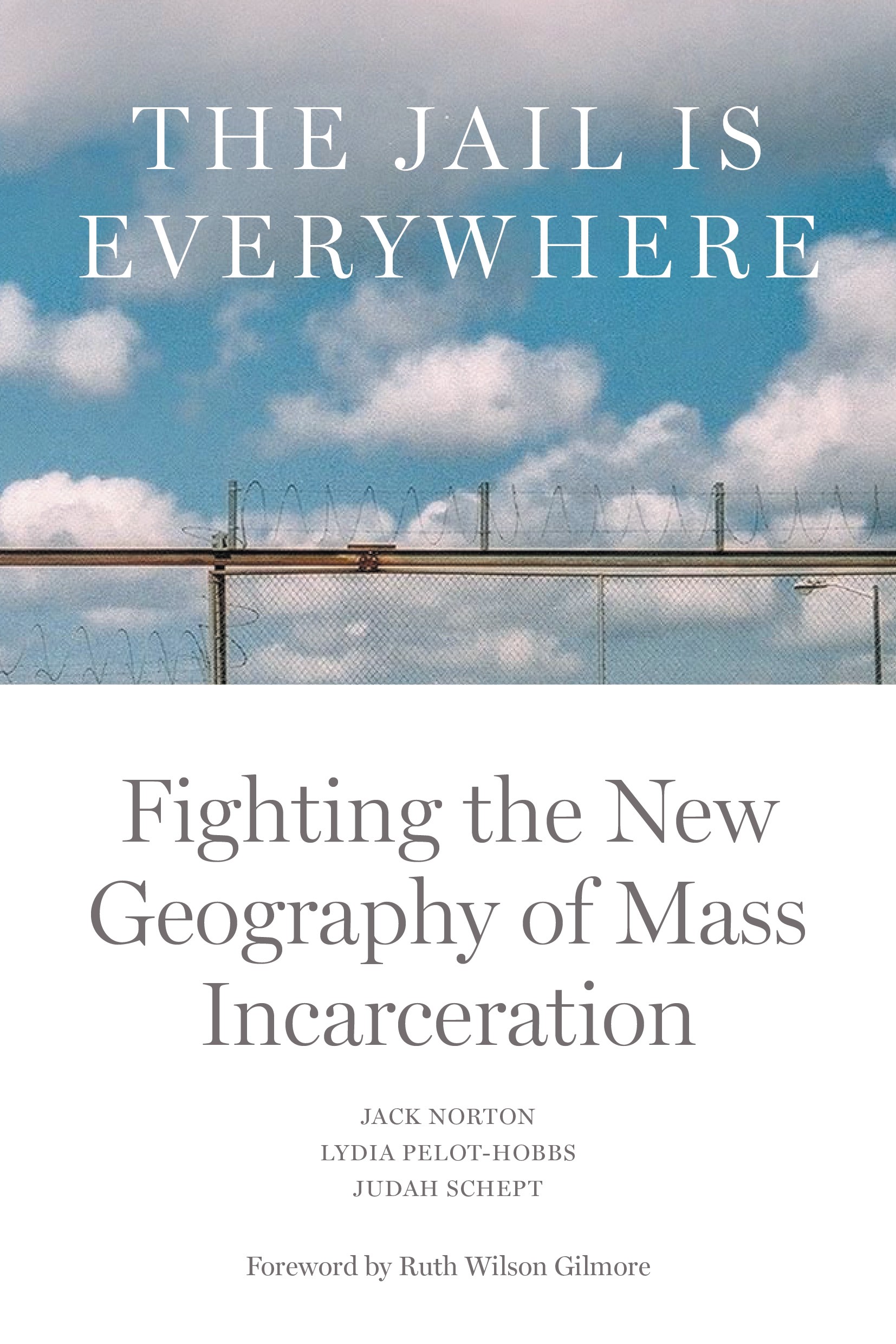“Somebody needs to force them to remember,” Edwin Rivera, incarcerated at Philadelphia’s Detention Center, pleaded in 2000. “We are somebody’s son, somebody’s father, somebody’s husband or brother.”
Rivera offered these remarks shortly after the end of an eighteen-year lawsuit, Harris v. Philadelphia. Since the implementation of a consent decree in 1986, the city’s overcrowded, majority Black, and notoriously brutal jails had been under the oversight of federal judge Norma Shapiro. But, following a relentless and sensationalized campaign from the city’s district attorney’s office and local media, the court’s once-promising attempts to reduce the city’s pretrial population had come to a close. Rivera’s plea—for the city, for anyone—to remember the plight of the more than 500,000 people imprisoned in jails across the United States, remains resonant.
Despite heightened attention to the crisis of racialized mass incarceration and the mainstreaming of calls for prison and police abolition, most attention has been dedicated to policing, sentencing, and incarceration in state and/or federal prisons. When the abuses and fights over local jails have punctured national narratives, they have usually involved major cities such as New York, Chicago, and Los Angeles. Yet The Jail Is Everywhere, a new volume on jails and those who organize against them, reports on a “quiet jail boom” across the United States. Rural counties now have the highest rates of jail incarceration in the country, even as their decentralized, hyper-local character encourages commentators to overlook them, treating their problems as “provincial” in character. As the contributors to this volume show, however, local jails are at the “center . . . of a new geography of mass incarceration.” Battles over their administration, growth, and construction will be key struggles in combating the evolving and frustratingly diffuse infrastructure for punishment in the years ahead.

The volume is organized by abolitionist scholars Jack Norton, Lydia Pelot-Hobbs, and Judah Schept. But the contributors to this volume are non-academic community organizers and activists engaged in contemporary fights against jail expansion and administration in diverse locales across the United States. This makes for a remarkably refreshing read, rooted in the messy but everyday realities of abolitionist organizing. The Jail Is Everywhere demonstrates that knowledge about the function of the carceral state and its multi-tentacled reach into U.S. politics, economy, and culture can only truly be unearthed through active struggle. “How do protagonists outsmart a monster?” Ruth Wilson Gilmore asks in her foreword to the volume. She answers, “They figure out how it works and what it needs.” And then, through “the energetic concentration of creative aggression,” they battle for a new world.
Although rarely acknowledged as such, the explosion in jails since the late twentieth century reflects a violent and ongoing restructuring of the state’s response and capacities to manage “crime.” Funding for jails has increasingly curbed or absorbed redistributive welfare programs, while providing a permanent mandate for officials to “herd, constrain, and sacrifice people.” As Andrew J. Pragacz and Kevin Revier write in an essay on organizing against jails in upstate New York, “the jail papers over the ever-growing ‘service gaps’ through its warehousing function.” In Atlanta, Xochitl Bervera and Wes Ware offer a similar view, describing how the construction of city jail prior to the 1995 Olympics “distort[ed] nearly every public health and safety policy, making arrests and detention the default ‘solution’ to houselessness, mental health crises, domestic violence, and substance use.”
The racial capitalist function of prisons and jails—what Gilmore calls the anti-state state—is not limited to repressing the political, physical, and economic enrichment of the nation’s racialized working class. Jails also, as Gilmore writes, “extract people from lives-in-motion in order to extract time from them.” This extraction of time from those caged, she explains, becomes a “commodity, that enables flows of carceral cash” such as “wages, debt service, rent, utility bills, vendor invoices, and so on.” These funds, in turn, secure the “futures” of other wealthy and often (but not exclusively) white individuals employed in jail administration and local government, along with the corporations, contractors, and vendors who service these carceral spaces.
More from our decarceral brainstorm
Every week, Inquest aims to bring you insights from people thinking through and working for a world without mass incarceration.
Sign up for our newsletter for the latest.
Newsletter
Several contributors illustrate the entanglement between jail administration and construction, helpfully clarifying why local governments remain committed to jails despite evidence of their harm, costliness, and failure. In a chapter on county jails and their role in immigrant detention, Silky Shah explains how county governments have come to rely on the cash flow provided by intergovernmental agreements with federal immigration agencies such as ICE and the U.S. Marshals Service. Brokered behind closed doors, these agreements quietly generate millions of dollars in revenue for counties by paying them a fixed amount to detain immigrants. This “symbiotic relationship” has led some sheriffs to push for expanding jails to generate more funds by jailing people in immigration detention. It has also caused sheriffs and local government officials to vehemently oppose efforts to end these contracts and/or shut down county jails. By following through on the incentives created by federal funding, county jails have become increasingly important sites of local revenue. In Etowah, Alabama, for example, one such agreement brought in more than $5 million a year in county revenue. When an Obama-era ICE proposed closing the jail, Etowah’s sheriff pleaded with the state’s Republican congressional leaders to prevent the closure, citing the financial benefits of the intergovernmental contract and its necessity for helping the county pay $3 million debt from prior jail expansions.
In other locales, jail expansion has endangered county budgets by transferring public wealth into the pockets of private creditors. Liz Blum describes an ongoing fight against jail expansion in Sacramento, which followed after litigation against extreme overcrowding in California’s prison system. Under the state’s 2011 Public Safety Realignment Act, individuals convicted of some low-level crimes now serve their sentences in county jails. To support this shift in carceral capacity, California legislators opened up large streams of capital for counties to expand their jails, primarily through the use of lease revenue bonds, or LRBs. A form of public debt, LRBs allow local governments to quickly fund construction projects without voter approval. These financial commitments tether counties to the repayment demands of creditors, and unlike other forms of infrastructure like bridges, do not guarantee revenue after construction. Instead, LRBs “lock the county into the ongoing fiscal cost of operating the jail” for decades, Blum writes, which means allocating more and more public funds towards county detention at the expense of other programs. Through LRBs, Blum argues, “the ruling class [can] exploit local austerity policies as a means to transfer public money into the private sector,” a transfer made possible by the intensification of state violence against primarily Black and brown working-class residents.
By exposing the hidden costs of LRBs and agitating around the county’s simultaneous proposal to cut school budgets, Blum and community members in Decarcerate Sacramento mobilized opposition. Rather than building jails, community members called for the county to invest in much-needed social services. Their pressure successfully convinced the Sacramento County Board of Supervisors to cancel a proposed expansion initiative spurred by the state’s realignment laws.
In response to local opposition against jail construction, boosters have increasingly turned to what longtime abolitionist activist James Kilgore calls carceral humanism. Rather than support jails for incapacitation, they are rebranded as “sites of care” that offer compassionate therapeutic rehabilitation. While there is a long history of policymakers and reformers situating jails as curative and corrective, Kilgore suggests that today’s iteration of carceral humanism is a product of distinct political and historical convergences that have made it especially durable and difficult to disrupt. Decades of punitive policymaking and neoliberal austerity governance have slashed or privatized services and “built out carceral capacities across every scale of the state” (as Norton, Pelot-Hobbs, and Schept write in their introduction), normalizing mass criminalization and imprisonment as a form of local social policy.
At the same time, a bipartisan criminal justice reform movement has emerged that, in their efforts to reduce overcrowded state prison populations, have transferred more people to county custody. Jails are now framed as places that provide mental or physical health services, substance abuse treatment, and/or gender-specific care (e.g., current proposals for a “feminist jail” in New York City). Some carceral boosters even vouch for jail expansion within a framework of racial justice. As Bervera and Ware describe in Atlanta, Fulton County sheriff Patrick Labat sought to co-opt Atlantans’ anger over racist police violence to promote new jail construction, and the alleged reduction in jail overcrowding, as justice reform.
Carceral humanism poses enormous challenges for abolitionist organizers. Portraying jail expansion proposals as a humane and social service–oriented endeavor—rather than a project premised on containing and punishing presumed criminals—makes jails appear as a benevolent arm of the state. These talking points have worked especially well with liberal and/or Democratic Party–aligned politicians, voters, and organizations who might otherwise be organizable into anti-jail coalitions, lulling them into a false belief that jails can be made into progressive institutions. As Kilgore quips in his chapter on fighting jail expansion in Champaign-Urbana, Illinois, Democratic legislators and even some well-meaning progressive activists “continually fall for the bullshit” of this “punishment-as-care” framework.
You don’t have to take Kilgore’s word for it. Some of the most compelling reflections on carceral humanism in the volume come from organizers who have seen firsthand how well-meaning demands to improve services end up being channeled toward “expanded carceral power and jail funding.” As Pragacz and Revier write about their efforts to block jail expansion in New York’s Broome County, their campaign initially called for both population reductions and better treatment for those inside, such as by increasing funding for improved mental health services. But they came to regret their “all-of-the-above” tactic, calling it “naïve” and “at odds with our stated goal to shrink the size and power of the jail.” They note that the “rhetoric of improved healthcare” had previously been used to justify an earlier expansion of the jail, and even after the county built this special “medical unit,” imprisoned people continued to experience harassment and abuse. Incarcerated people, meanwhile, were still dying due to medical neglect. “We must now be even clearer that not one more dollar should go to the jail, in any form or fashion,” they conclude.
One enormous—and ironic—wrench in efforts to confront more humanist justifications for jail expansion comes from an unlikely source: prison conditions litigation. Several contributors detail how lawsuits, launched by imprisoned people wishing to challenge inhumane conditions and treatment, often become tools for expanding a county’s carceral capacity. Despite imprisoned plaintiffs’ frequent contention that humane care is antithetical to imprisonment, suggesting the need to decarcerate and close jails, these lawsuits end up offering a “bureaucratic scapegoat” for local officials to assert that they must build more or expand their jails to fix conditions and comply with consent decrees. In New York’s Rikers Island jail complex, for example, litigation meant to challenge overcrowding and use of force after the death of Kalief Browder has “either backfired or been inconsistent with abolitionist strategy in the long run,” according to Mon Mohapatra. Local officials easily contort plaintiffs’ claims about overcrowding, violence, poor medical or mental health care, lack of ADA compliance, and more into plans for renovations, expansions, and new construction.
In some cases, federal judges actually go against the desires of local officials who, in response to community opposition, want to block new jail construction. As Lexi Peterson-Burge details in Orleans Parish, Louisiana, the federal judge overseeing a consent decree placed on a jail in 2012 due to a host of abuses began to threaten to hold the New Orleans City Council in contempt of court if they did not build a new jail. Community pressure pushed council members to delay construction, and even helped elect a progressive sheriff opposed to jail construction. That support came undone in 2022, when the election of more “pro-carceral” council members proved more susceptible to the judge’s pressure and supported new jail construction.
As Blum notes, however, litigation can serve strategic ends, too. During its campaign, Decarcerate Sacramento realized that even if officials cited federal lawsuits as a way to justify further jail expansion, nothing in the case mandated the county build a new jail. Officials’ proposals were merely a carceral interpretation of how to satisfy the consent decree. In response, the group advocated for a reduction in the number of people jailed as “the only possible solution” to ongoing problems faced by incarcerated people. In doing so, the campaign reminded the city and the broader community that, when it comes to ameliorating harmful jail conditions, decarceration is always an option. “Imagine if consent decrees ordered jail closures and required local governments to build preventative and alternative noncarceral infrastructure in communities,” writes Blum.
A strength of The Jail Is Everywhere is its willingness to confront the disagreement inherent to all movement work, anti-jail organizing included. Holding the abolitionist position of opposing the flow of any and all money toward local jails, for example, is not as politically straightforward as it may seem. Real questions arise about whether it is “callous and cruel toward those locked up inside” to refuse to support improved health care, legal support, food, and other services in local jails. At least a few of the volume’s contributors appear provisionally open to less hard-line approaches. Amelia Kirby’s piece on her Chan Zuckerberg Initiative–funded work with the Foundation for Appalachian Kentucky (FAK), for example, describes how the FAK channeled resources into Floyd County jail to support reentry and legal aid for imprisoned people as part of a broader effort to get people out of jail and prevent new construction. While aware of the “ongoing contradictions” of trying to do abolitionist work within the structure of a private, capitalist foundation that appears willing to work with and send resources to jails, Kirby’s chapter suggests that an “imperfect vessel” can still help us to make a less punitive world.
The volume suggests that in the struggle to fight the behemoth of mass criminalization, we cannot afford to paralyze ourselves by demanding purity and tactical rigidity. This is not to say that the details of anti-jail struggles don’t matter, nor should it discourage organizers from offering principled critiques of well-meaning campaigns and their approaches. As the chapters in this volume make clear, efforts to decarcerate and abolish jails are too often coopted by presumed allies or organizations that channel movement demands toward carceral ends. Organizers should be especially wary of fair-weather friends who promote abolitionist campaigns when politically convenient but turn away from them once in a position of power, as Bervera and Ware discuss regarding the trajectory of Atlanta mayor Keisha Bottoms. Once a champion of closing Atlanta’s detention center, Bottoms “changed like the weather” once in office, ultimately sustaining the status quo and stalling activist demands to close the jail swiftly.
These chapters also furnish further evidence that fighting mass imprisonment is a local fight. Indeed, one of the core takeaways from the book is the substantial power that local officials have to determine the flow of individuals into jails or not, a point that helpfully refutes the claim that incarceration is inexorable, apolitical, and preordained. That openness also means that organizers will inevitably experiment, devising strategies that may differ and even be in tension with one another. Some abolitionists might bristle, for example, at Kilgore’s proclamation that organizers have to “build relationships with the decision makers and be able to engage with the existing system.” The same can be said of Sarah Westover and Matt Witt’s advice to “set aside partisan politics” in collaborating with Republicans, an insight they gleaned from successfully blocking new jail construction in a rural county in southern Oregon. As Norton, Pelot-Hobbs, and Schept suggest in their conclusion, organizers should be flexible, moving between what is necessary to block the local expansion or new construction of jails—which may or may not involve an ideological transformation of the communities with whom they organize or align—and promoting more radical political education that can restructure how people understand criminalization, imprisonment, and racial capitalism writ large. “We are dialectically working to shape conditions on the ground as well as the ways in which our communities understand then,” they write, even as the timelines for these political projects may not always perfectly align.
These efforts suggest that the future of responding to and mitigating harm with force, control, and incapacitation is not set in stone. Communities across the country are organizing sophisticated campaigns to challenge this kneejerk embrace of cages over care, refusing the temptation of cynicism and paralysis in the face of a daunting carceral foe. “Our backs are to the wall,” Gilmore writes. Obstacles abound. But the stories in this book make the struggle against jails feel, if not easy, then at least actionable. We can, and we must, outsmart the monster.
Image: Md Mahtab/Unsplash

